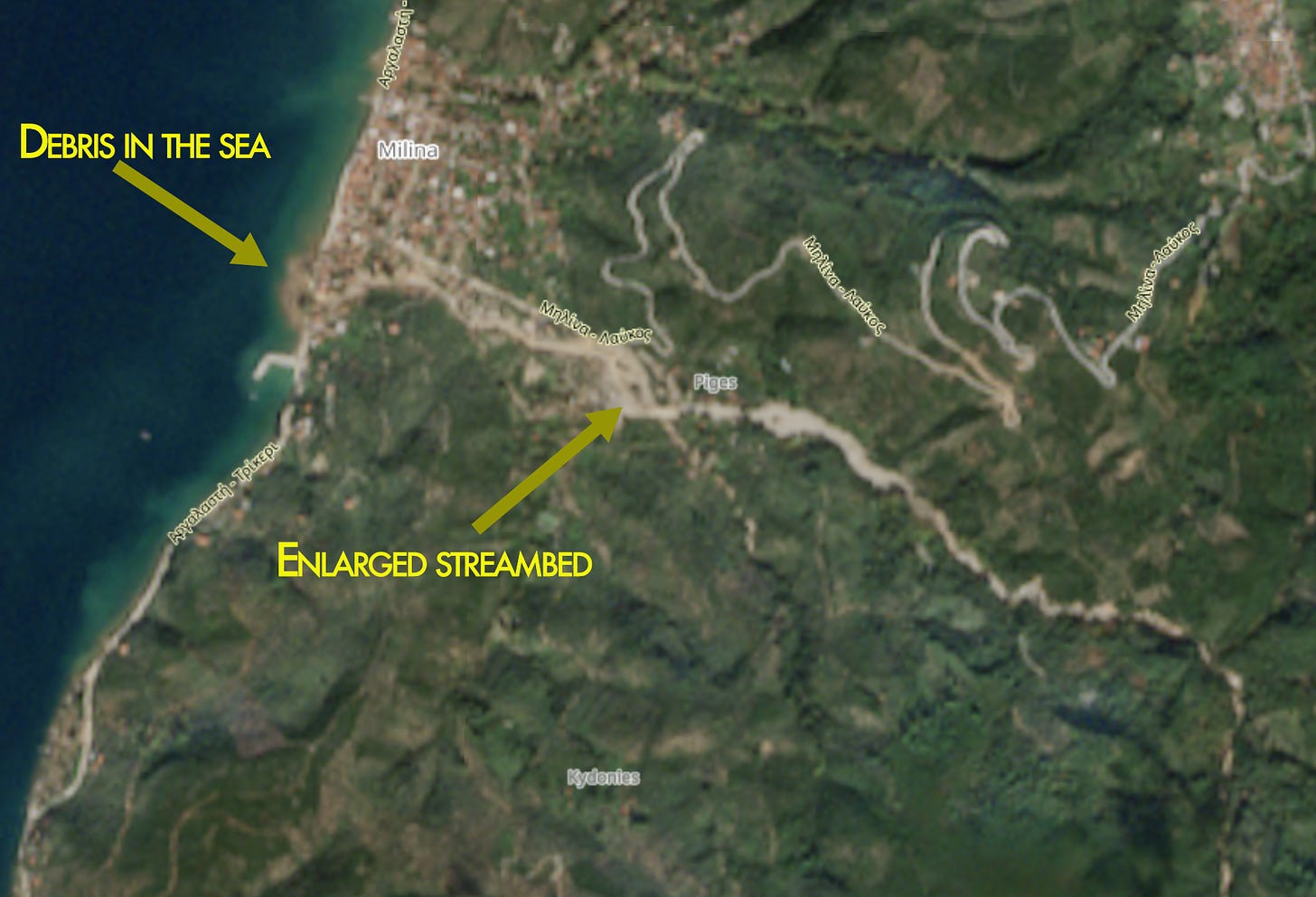Two months have passed since “bad weather” Daniel wreaked havoc on our lives, the Pilio, and the greater Thessaly region. Recovery is happening for some, but it is painfully slow for most. In Milina, one of the hardest hit villages, a handful of business establishments are up and running and when you sit there and munch on your taramasalata (a delicious fish roe paste) on a warm Sunday afternoon, you might think all is normal. But look around and you’ll soon notice the murky color of the sea, the debris in the water, the shuttered shop next door with the shattered windows.
Yesterday we dined next to the sea at a Milina restaurant then ventured deeper into the town to see a house that we once had considered buying. Because it was in Milina it was relatively expensive ($125,000), but it had a big yard and was in a quiet, shady, lush place just footsteps from the sea and the tavernas. It also sits near the banks of one of two big arroyos that run through town, the arroyos that dealt most of the destruction upon Milina after some four feet of rain fell on surrounding hills.
We made our way through piles of debris, cars that looked like they had escaped from the wrecking yard, soggy mattresses, trees that looked like they had been thrown around by the gods. The reminders of the mayhem increased in quantity as we neared the arroyo. It took us a bit of back and forth to find the house. It still stood, jutting out nakedly from a sea of drying mud. Everything that once surrounded it, the outbuildings, the fences, the trees and shrubs and garden accessories, were gone.
Next door a woman stood in her driveway, surrounded by the things that survived — jars of spoon sweets, dishes, some clothes — and tried to remove the silt with a power washer. “This used to be the prettiest place in Milina,” she said. “Now … I don’t know if I can be here anymore.”
Before Sept. 5 the arroyo was not even that noticeable in places, so overgrown it had become with trees and brush. After a rain a little creek would run through it, but not much more than a trickle. But Daniel transformed it into a monster, radically altering the streambed.


The cleanup continues and will do so for months, maybe years. The other night, after doing a day of cleanup at our own house in Koukouleika, I rode my bike back to Argalasti, where we’re renting a house. The wind was whipping and in Milina, the waves were crashing against the shore. On the one hand it was glorious. On the other, it was filling the street and sidewalk with water — another flood, this one from the sea.
But enough of the flood. It’s a glorious autumn in southeastern Europe and we had a chance to enjoy some of it in Sofia, Bulgaria. Driving to Bulgaria from the Pilio is a bit like driving to Denver from Durango, which still strikes me as odd. These places are so close to each other, relatively speaking, but the climate, landscapes, and cultures are so different. We first stayed at Yarlovo, which is on the opposite side of Mt. Vitosha from Sofia. It’s a quiet little village surrounded by forests and rolling hay and sunflower fields stretching out to the high peaks of the Rila Mountains. It’s wonderful for running once you find the right trails and sneak around the barking dogs. The Yarlovo wanderer is likely to see buildings constructed using the wautle and daub method (first photo below). Some of the barns had lost their plaster, exposing the lovely skeletons. A nature school made up of geodesic domes sits atop a hill just outside the village. And I stumbled upon what appeared to be an ancient pagan shrine that had been coopted by Christians in more recent times (in the center of the shrine was a hollowed out stone).






Sofia, meanwhile, is as vibrant as ever. The low cost of living has attracted artists and entrepreneurs and digital nomads, which in turn has created a market for interesting foods and businesses, which makes visiting a rather yummy experience. It is also somewhat sad, knowing that Sofia has now reached its pre-gentrification phase and it’s only a matter of time …
Speaking of entrepreneurs and art and creativity and, well, capitalism and gentrification: You can now get Auslander and Land Desk and Lost Souls Press swag, including totes and t-shirts, mugs and insulated water bottles, and even notebooks imprinted with our photos and artwork. Here’s a sampling of the offerings. For more, visit the Lost Souls Press Store and come back often since we’re adding new items all the time (we’re also open to suggestions, special requests, and custom designs).









Bittersweet message. Your writing is so darn good and your recent stories of hardships and beauty too are both heartbreaking and inspiring. Stay strong Jonathan and Wendy 🥰